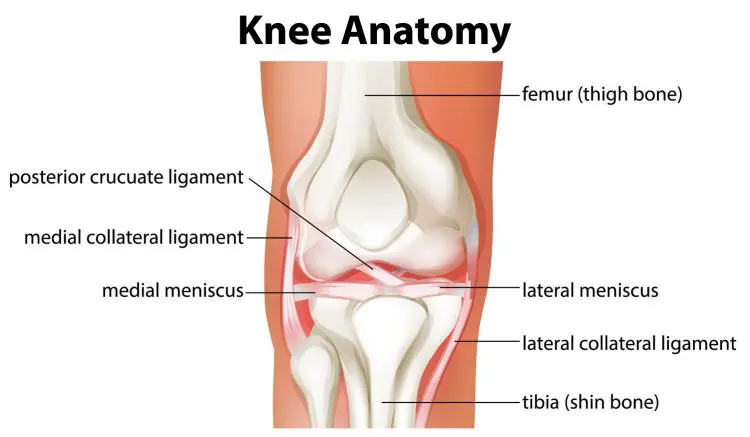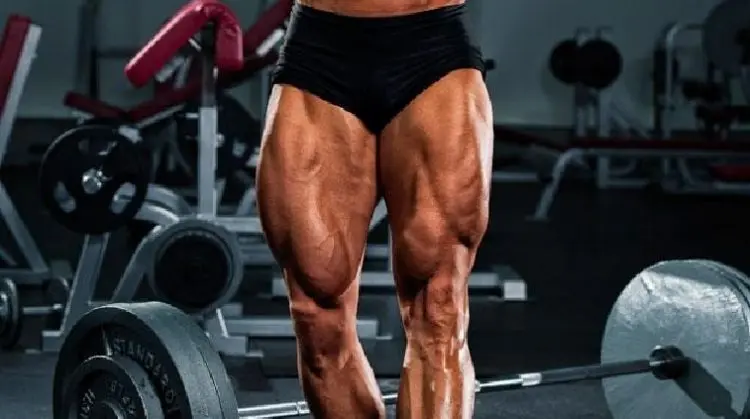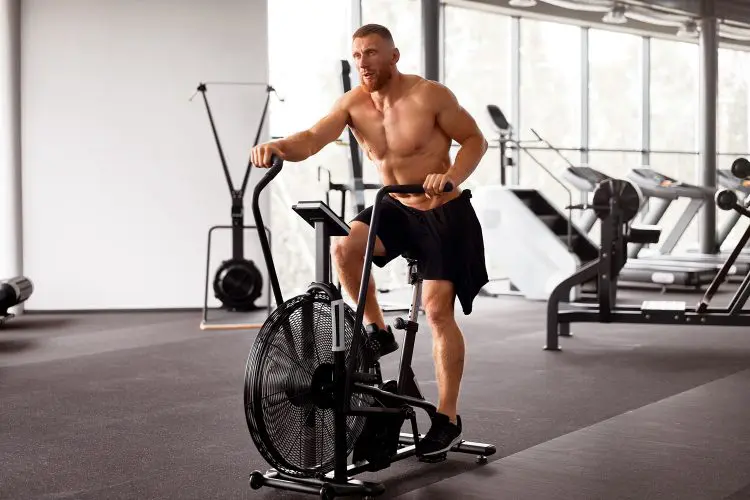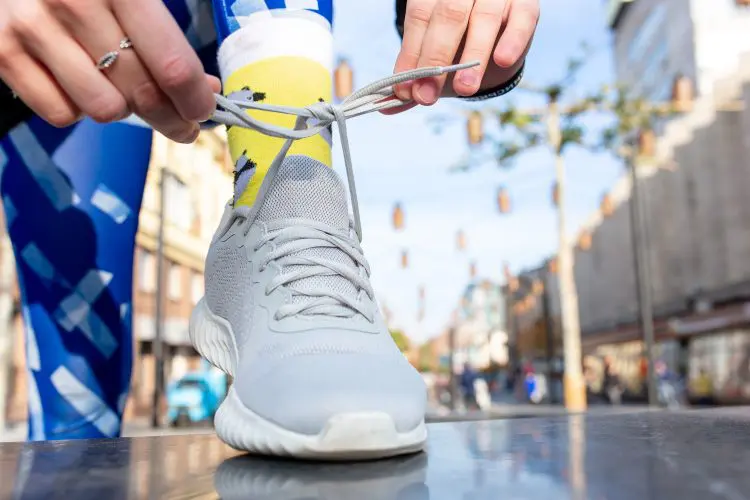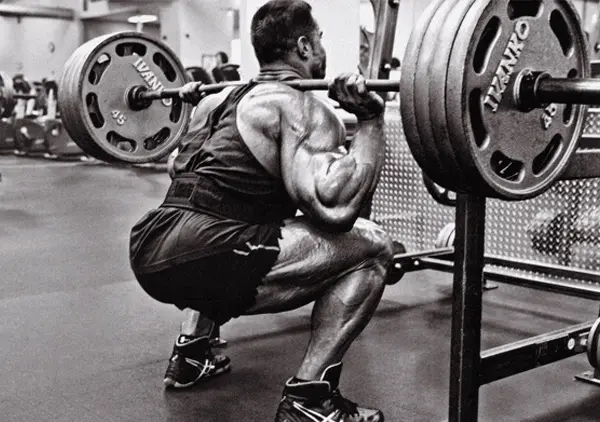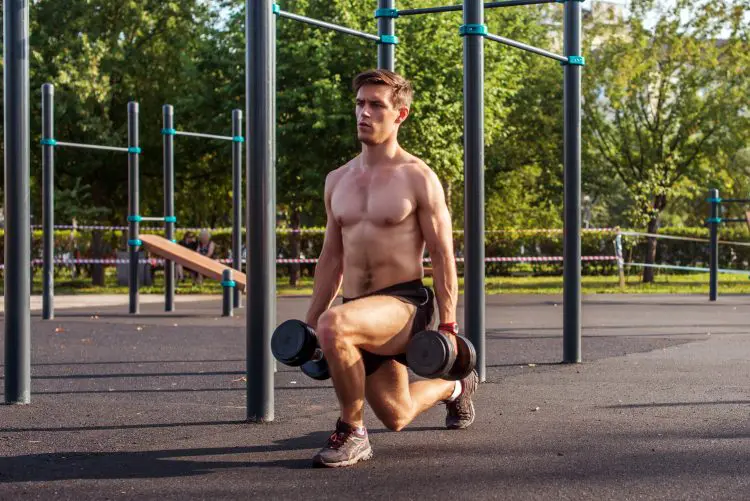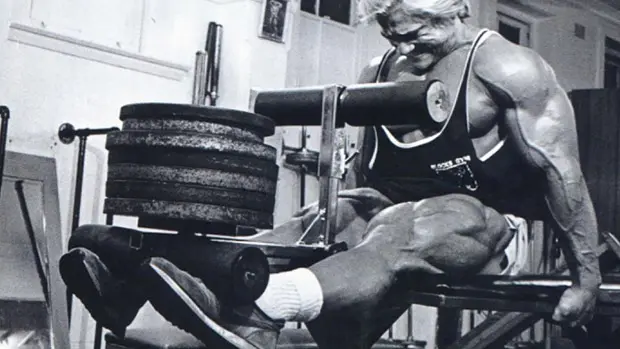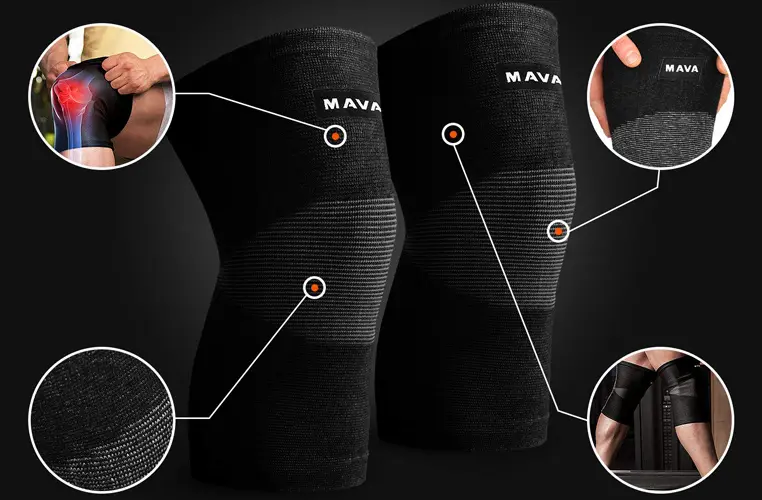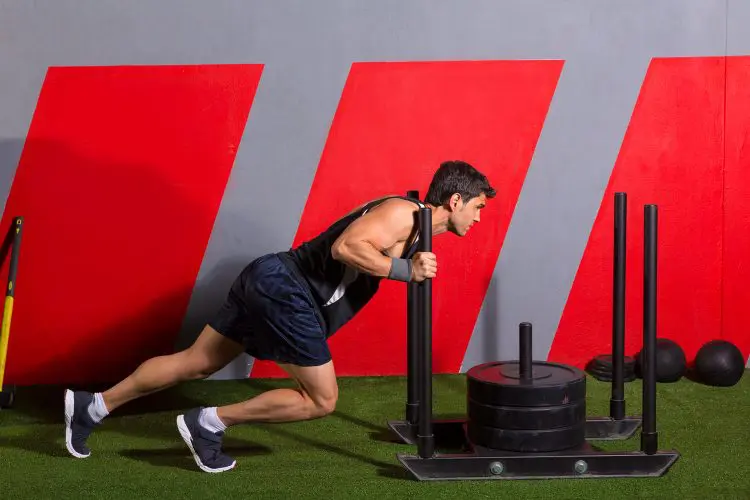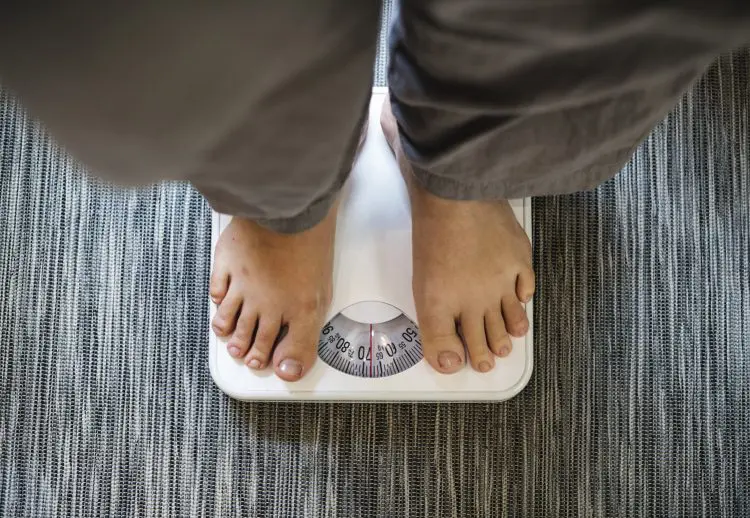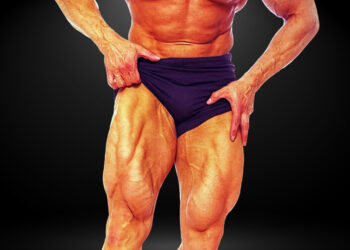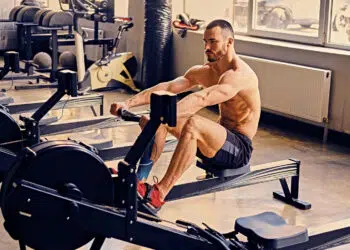Pain-free, healthy knees are one of those things we tend to take for granted. But, once knee pain takes hold, it can turn lower body training and cardio into a miserable experience. Even everyday activities like walking or climbing stairs can become a chore.
Knee pain can be acute or it can be chronic. Acute knee pain comes on rapidly, whereas chronic knee pain is insidious and develops gradually. Either way, knee pain is best avoided, and it’s something we don’t wish on even our worst enemies!
Knee pain is very common in exercisers. It’s partly due to the wear and tear of living an active lifestyle. But that doesn’t mean you HAVE to become another victim of knee pain. In this article, we’re going to examine the major causes of gym-related knee pain and provide you with 15 practical strategies for avoiding it.
Knee Anatomy Basics
The knee is a hinge joint, and, like a door or cupboard hinge, it opens and shuts. The bones that make up the knee are the femur or thigh bone and the tibia, which is the bigger of your two shin bones.
Unlike the hip and shoulder, the femur and tibia do not come together to form a ball and socket. Instead, the ends of the bones are held together by ligaments, and the end of the femur sits in small cartilaginous structures calls the meniscus.
The names and functions of the knee ligaments are:
Level Up Your Fitness: Join our 💪 strong community in Fitness Volt Newsletter. Get daily inspiration, expert-backed workouts, nutrition tips, the latest in strength sports, and the support you need to reach your goals. Subscribe for free!
- Anterior cruciate ligament prevents the femur from moving backward on the tibia.
- Posterior cruciate ligament prevents the femur from moving forward on the tibia.
- Medial and lateral collateral ligaments prevent the femur from moving sideways.
The end of the femur is covered with a layer of hyaline cartilage, which promotes smooth movement and protects the bone from wear and tear. Cartilage is avascular, which means it has a poor blood supply. Once damaged, such as in a meniscal tear, it is very slow to heal, and damaged sections may need to be repaired or removed surgically.
The articulations of the knee joint are:
- Extension – straightening your knee
- Flexion – bending your knee
- Medial rotation – turning your lower leg inward*
- Lateral rotation – turning your lower leg outward*
*These are small movements that can only really happen when your knee is bent.
The movements of the knee are affected by several muscles, with the main ones being:
- Quadriceps – consisting of vastus lateralis, vastus intermedius, vastus medialis, and rectus femoris, the quadriceps extend your knee. Rectus femoris also flexes your hip.
- Popliteus – a small muscle behind the knee that initiates flexion.
- Hamstrings – the collective name for the semimembranosus, semitendinosus, and biceps femoris. The hamstrings flex your knee and also extend your hip.
- Sartorius – the longest muscle in the human body, the Sartorius, also known as the tailor’s muscle, flexes the knee.
- Gastrocnemius – the larger of the two calf muscles, gastrocnemius works with your hamstrings to flex your knee. However, this action is relatively weak.
It is not the aim of this article to identify the cause or nature of existing knee pain. That’s a job for a qualified medical professional. However, some of the conditions that we hope to help you avoid include:
Strains and sprains – strains affect the muscles while sprains affect the ligaments.
Osteoarthritis – wear and tear of the hyaline articular cartilage within the knee joint.
Knee crepitus – grinding or popping within the knee joint, which could be a precursor of osteoarthritis.
Meniscal tears – damage to the meniscus.
Patellar tendonitis – inflammation and swelling of the tendon that connects the kneecap to the tibia.
Patellofemoral pain syndrome – pain behind the patella, often caused by roughening of the inside of the patella or kneecap.
Bursitis – inflammation of the fluid-filled sacks that reduce the friction between tendons and bones.
Iliotibial band syndrome – a condition where the iliotibial band, which runs down the outside of the thigh, rubs against the outside of the knee joint, resulting in inflammation and knee pain.
Tendonitis – inflamed, swollen tendons.
Tendonosis – degeneration of the tendons.
The knee joint is a weight-bearing joint, and that means it’s under almost constant stress. Needless to say, that stress increases dramatically when you put a heavy barbell on your back and start banging out squats. The knees are also susceptible to traumatic injuries, such as when powerlifter Alexander Sedykh broke both knees in a failed 400kg squat attempt.
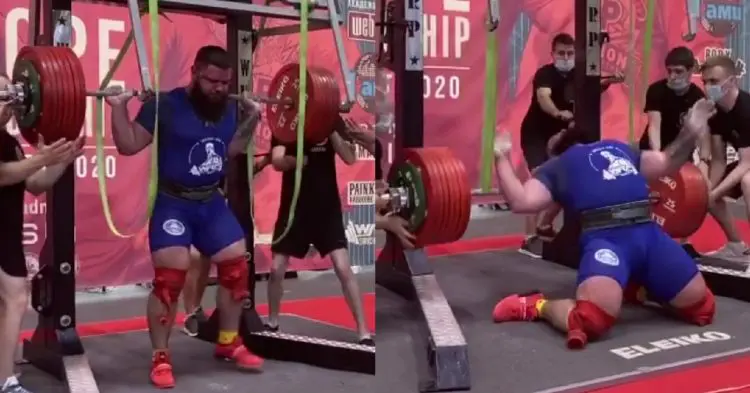
15 Ways to Prevent Knee Pain at the Gym
The knee joint is the largest and most robust joint in the human body. It’s also one of the most abused. Most people tend not to think about knee pain until it stops them from doing what they want to do.
Most exercisers will experience at least a little knee pain as the knee joint is subject to unavoidable wear and tear. The trick is to minimize that damage and keep knee pain to a minimum.
Here are 15 ways to prevent new and manage existing knee pain. However, despite these interventions, if your knee pain worsens, you should stop training and get it checked out by a qualified medical professional, preferably one who specializes in sports injuries.
1. Warm-up for longer
You should NEVER work out without a proper warm-up but warming up is especially important for preventing knee joint pain. Your knees are a synovial joint, which means they are lubricated with an oil-like substance called synovial fluid. Synovial fluid is produced on demand.
If you start working out before you’ve had a proper warm-up, your joints will be “dry,” and that will increase cartilage wear and tear. That’s why knee pain often diminishes as your workout goes on – more synovial fluid is being produced.
If you are about to hammer your knees with heavy squats and leg presses, spend a few extra minutes warming up your knee joints. Stationary cycling is an excellent warm-up activity.
2. Wear the right shoes
While we’re not saying you need to wear Olympic lifting shoes for your leg workouts, we do suggest you wear footwear with plenty of support and that won’t collapse under heavy weights.
Many exercisers wear running shoes or standard sneakers. While comfortable, these shock-absorbing shoes are prone to compressing during heavy squats and leg presses. This can cause your feet to roll inward or outward, increases the lateral stresses on your knees.
Running shoes are ideal for high-impact cardio and upper body workouts, but for serious leg training, they could be a liability. Equip yourself with firmer, more stable shoes to minimize stress on your knees.
3. Regulate your squat depth
“Go deep or go home” might make for a good T-shirt or meme, but when it comes to squats, very deep squats could cause knee pain and injuries. Optimal squat depth is determined by several factors, including femur length, muscle flexibility, hip mobility, ankle mobility, and knee joint health.
Forcing yourself to squat deeper than nature intended could result in acute and chronic knee injuries. Squat as deep as you comfortably can, and don’t worry if that isn’t ass to grass.
Read more about determining optimal squat depth here.
4. Balance your quads and hamstrings

Take a look at your training diary and see if you are doing more work for your quads than your hamstrings, or vice versa. If you are, shore up any imbalances by doing more of whatever your workout is lacking.
One way to do this is by performing agonist/antagonist supersets, for example:
5. Do more single leg exercises
Bilateral or two-legged exercises allow you to lift a lot of weight. Those large loads put a lot of compressive force through your knees, which will cause increased wear and tear. You probably won’t be able to lift anywhere as much weight with unilateral or single-limb exercises. For example, you might be able to squat 140kg but cannot do even one single-leg squat.
Take some weight off your knees by doing more single-leg exercises. Good options include:
As well as reducing the amount of weight you can lift, unilateral exercises are also useful for increasing balance, stability, and mobility, all of which will enhance knee health.
Level Up Your Fitness: Join our 💪 strong community in Fitness Volt Newsletter. Get daily inspiration, expert-backed workouts, nutrition tips, the latest in strength sports, and the support you need to reach your goals. Subscribe for free!
6. Watch out for excessive forward knee travel
While you don’t have to keep your shins perfectly vertical when you train your legs, you should try to avoid letting your knees travel forward and beyond your toes during exercises like squats, leg presses, and lunges.
Excessive forward knee travel puts a lot of pressure on your patella tendon and also increases knee joint stress. Draw an imaginary vertical line up from your toes and try to keep your knees behind that line. As a general rule, the closer your shins are to vertical, the less stress there will be on your knees.
7. Go easy on the impact
Exercises like running and jumping are useful for developing fitness, conditioning, and power but can take their toll on your knees. It’s not the taking off that’s the problem, but the landing. Heavy landings compress your knee joints, squeezing the synovial fluid to the side of the knee joint capsule, which means less lubrication.
Those same heavy landings expose your joints, muscles, and connective tissues to massive forces – 1.5 x 3 times body weight during running and 8 – 11 times bodyweight in jumping (1).
If you are a runner, then you should include plenty of running in your workouts. But, if you aren’t, there are other, more knee-friendly ways to work out. Similarly, athletes probably need to include high-impact jumping exercises in their workouts but, for general exercisers, such movements are riskier than they are beneficial.
8. Do not allow your knees to roll in or out
Lack of joint stability can increase stress. If your knees roll in or fall out when you squat, lunge, or even deadlift, instead of spreading your weight across the entire articular surface of the joint, you’ll shift it laterally to the inside or outside of your knees. This is called point loading.
Single leg exercises can help improve knee stability, as will lower body BOSU exercises. You also need to practice self-awareness and keep an eye on your knees as you work out. If you see your knees deviating in or out, you should stop what you are doing and do a different exercise.
9. Make sure your toes and knees are pointing the same way
It’s a lesser-known fact that your knees don’t just flex and extend; they also rotate. However, that range of rotation is relatively small – up to 45 degrees external and 25 degrees internal rotation – and can only occur when the knee is unlocked. When the knee is straight, rotation comes from the hip.
Because of this anatomical factoid, it is possible for your knee to be pointing one way and your foot to be pointing another.
Loading a twisted knee exposes it to uneven wear and tear and places a lot of stress on the stabilizing ligaments. Avoid this potential source of pain and injury by ensuring your knees and toes are always pointing in the same direction. This is especially important during exercises like lateral lunges and lateral jumps.
10. Don’t go super-heavy on leg extensions
Leg extensions are a very useful quadriceps isolation exercise. They’re good for building muscle and increasing local muscular endurance. Leg extensions can also help you get a fantastic pump!
However, they also expose your knees to a lot of shearing force. The seat supports the back of your femur, but your knee and lower leg are unsupported, placing a lot of stress on the anterior cruciate ligaments.
We aren’t telling you to ditch leg extensions, but if they cause you knee pain, you probably should. Instead, we suggest using light to moderate weights and moderate to high reps. Use a slower tempo to make lighter weights more challenging. Alternatively, try blood flow restriction training to intensify your workouts without hammering your joints with huge loads.
11. Stretch more
Tight quadriceps, hamstrings, and calves can have a detrimental effect on knee function and health. Tight muscles can reduce your range of motion, forcing you to make movement modifications and accommodations that put more stress on your joints.
For example, if you have tight calves, your heels are more likely to lift during squats, pushing your weight forward onto your toes. This will cause your knees to travel forward, which, as you know from point #6, can be a source of knee pain.
Do these stretches daily to increase knee-specific flexibility.
1. To stretch your quads, lie on your front with your legs together and your head resting on one arm. Reach your other arm down and back and, bending your leg, take hold of your foot. Gently pull your foot into your butt. If you need a deeper quad stretch, try the couch stretch exercise. Hold for 30-60 seconds and then swap sides.
2. To stretch your hamstrings, lie on your back with your legs straight. Lift one leg and loop a belt, towel, or stretching strap over your foot. Use your arms to pull your extended leg toward you. Hold for 30-60 seconds and then swap sides.
To stretch your calves, stand with your feet on the edge of a sturdy step. Using your arms for balance, lower your heels as far down below your toes as you can. Keep your legs straight to target your gastrocnemius muscle, and then bend your knees slightly to hit the smaller soleus muscle. Hold each position for 30-60 seconds. You can also do this exercise with one leg at a time.
12. Don’t dive-bomb your squats
Because of something called the stretch reflex, the faster you stretch a muscle, the more powerfully it will contract. In straightforward terms, the stretch reflex allows you to bounce powerfully out of the bottom of exercises like squats and leg presses.
However, while this reflex may allow you to lift heavier weights, “dive-bombing” your squats puts a lot of stress on your knees – the joints, muscles, tendons, and ligaments.
Take stress off your knees by descending slowly, smoothly, and under control. Better still, pause at the bottom of each rep for 1-2 seconds to increase time under tension and make your workout more demanding.
Dive-bombing might allow you to lift more weight or do more reps but actually makes your workout easier. Slow down to increase muscle tension and reduce joint stress.
13. Try knee sleeves
Knee sleeves can help keep your knee joints warm and provide them with a little extra support during squats, leg presses, etc. They are not an instant cure or preventer for knee pain, but they can help.
The best knee sleeves for knee pain are made from neoprene, which is elastic, insulating, and flexible. Your knee sleeves should fit snugly but not be so tight you need to take them off between sets.
Knee sleeves are VERY different from knee wraps. Knee wraps increase knee stiffness for a better rebound out of the bottom of squats. Powerlifters use knee wraps to boost their squat performance. Knee wraps do work but increase knee stress as they bunch up behind your knee.
If you aren’t a powerlifter, there is no real benefit to using knee wraps in your training. And even if you ARE a powerlifter, you should save your knee wraps for your heaviest sets and the last few weeks before a competition to protect your knees from unnecessary wear and tear.
14. Try weighted sled drags for size and strength
What do squats, lunges, and leg presses all have in common? Lots and lots of knee compression. With a barbell on your back or dumbbells in your hand, your muscles AND joints are put under tremendous pressure.
If your knees are starting to bother you, try doing weighted sled drags instead of your usual leg workout.
With weighted sled drags, there is minimal compression on your knee joints, but your muscles still have to work hard. Do front-facing sled drags to work your hamstrings, pull it backward to work your quads, and go sideways to target your inner and outer thighs.
Read more about weighted sled training here.
15. Achieve and maintain a healthy body weight
Being overweight increases your risk of developing osteoarthritis. This is when the articular hyaline cartilage starts to wear away. Osteoarthritis can also cause bone spurs, which is unregulated bone growth inside the knee joint. This is every bit as uncomfortable as it sounds.
Severe osteoarthritic knee joints can be surgically replaced, but even the best artificial joint is not as good as the one designed by Mother Nature.
If you care about your knees, try to reach and maintain a healthy body weight. Being lighter will put less stress on your knees both in and out of the gym. Also, if you are overweight, take extra care with high-impact activities such as running. Running is hard on your knees when you weigh 140lbs, let alone if you are 200lbs+.
What is a healthy weight? That’s an impossible question to answer because it depends on things like your body type and how much muscle you are carrying. But, needless to say, if you are overfat, you’ll probably be overweight too, so keep an eye on your body composition.
Also read:
- 13 Ways to Avoid Shoulder Pain in The Gym
- 13 Ways to Prevent Elbow Pain When Working Out
- How To Build Big, Functional Quads Without Knee Pain
- Oblique Pain: Muscle Strain Or Sports Hernia?
- The Importance of Sleep for Building Muscle and Losing Fat
Wrapping Up
It’s difficult to think of a more hardworking joint than the knees. Your knees have to support large loads through big ranges of motion in the gym and then support your body weight as you go about the rest of your day. It’s hardly surprising that so many exercisers have ongoing issues with knee pain.
While most people will suffer occasional and hopefully minor knee aches and pains, heavy strength training can turn a small problem into something far more debilitating. Knee injuries are often severe and can take many weeks or even months to heal. That’s why, when it comes to knee pain, prevention is better than cure.
Use the strategies in this article to help prevent knee pain or give any minor problems a chance to heal. Remember, though, if your knees don’t start feeling better soon or start to get worse, you should seek medical advice.
References:
1. PubMed: An experimental and analytical study of impact forces during human jumping https://pubmed.ncbi.nlm.nih.gov/2577952/

